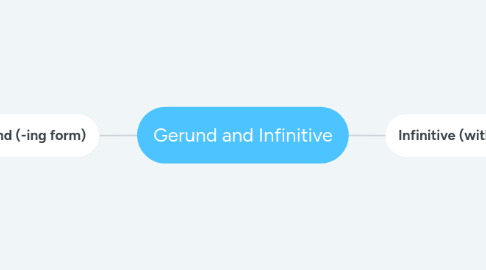
1. Gerund (-ing form)
1.1. Continuous verbs (Present continuous, Present perfect continuous, Past continuous)
1.1.1. I am studying right now
1.1.2. He has been training for weeks
1.1.3. We were studying when we heard a noise
1.2. After Prepositions
1.2.1. It's no use \ There's no point in \ look forward to \ be busy
1.2.1.1. There's no point in crying over spilled milk
1.2.2. Instead of \ without \ after \ before \ besides \ by (con)
1.2.2.1. Janet left the party without saying goodbye
1.2.3. Be interested in \ be good at \ think of \ insist on
1.2.3.1. I'm good at playing tennis
1.3. After certain Verbs
1.3.1. Like\dislike
1.3.1.1. I love smelling Napalm in the morning
1.4. As a noun
1.4.1. Reading is my favourite way to relax
1.5. To replace relative pronouns. In this case the gerund works as an adjective
1.5.1. The man (who is) speaking is an old friend of mine
2. Infinitive (with "to")
2.1. Purpose
2.1.1. They left early to avoid traffic
2.1.2. Io sono andato al sushi per mangiare pesce
2.1.2.1. I went to the sushi restaurant to eat fish
2.2. After adjectives
2.2.1. Emotions (happy, sad, pleased, surprised, eager, willing)
2.2.1.1. I'm happy to hear that
2.2.2. Opinions (bad, good, hard, easy, nice, clever (im)possible, kind)
2.2.2.1. It's hard to understand that
2.2.3. After adjectives with too and enough
2.2.3.1. It's too cold to go outside
2.3. After certain verbs
2.3.1. Choose, Decide, Need, Offer, Learn, Want, Would like, Agree, Teach
2.3.1.1. I want to visit Madrid
2.4. After How \ Who \ What \ When \ Where \ Whether
2.4.1. He seems undecided whether to go or not
2.4.2. Can you show me how to use this mobile phone?
